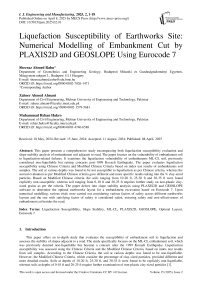Liquefaction Susceptibility of Earthworks Site: Numerical Modelling of Embankment Cut by PLAXIS2D and GEOSLOPE Using Eurocode 7
Автор: Sheeraz Ahmed Rahu, Zaheer Ahmed Almani, Muhammad Rehan Hakro
Журнал: International Journal of Engineering and Manufacturing @ijem
Статья в выпуске: 2 vol.15, 2025 года.
Бесплатный доступ
This paper presents a comprehensive study encompassing both liquefaction susceptibility evaluation and slope stability analysis of embankment soil adjacent to road. The paper focuses on the vulnerability of embankment soil to liquefaction-related failures. It examines the liquefaction vulnerability of embankments ML-CL soil, previously considered non-liquefiable but raising concerns post-1999 Kocaeli Earthquake. The paper evaluates liquefaction susceptibility using Chinese Criteria and Modified Chinese Criteria based on index test results of embankments soil samples. The soil at various depths was found to be not susceptible to liquefaction as per Chinese criteria, whereas the second evaluation as per Modified Chinese criteria gave different and more specific results taking into the % clay-sized particles. Based on Modified Chinese criteria, the soils ranging from 10-20 ft, 25-30 ft and 30-35 ft were found explicitly non-susceptible, whereas soil ranging from 0-10 ft and 20-25 ft requires further study on non-plastic clay-sized grains as per the criteria. The paper delves into slope stability analysis using PLAXIS2D and GEOSLOPE software to determine the optimal earthworks layout for a embankment excavation based on Eurocode 7. Upon numerical modelling, various trials were carried out considering various factors of safety across different earthworks layouts and the one with satisfying factor of safety is considered safest, ensuring safety and cost-effectiveness of embankment cut besides the road.
Liquefaction Susceptibility, Slope Stability, ML-CL, PLAXIS2D, GEOSLOPE, Optimal Layout, Eurocode 7
Короткий адрес: https://sciup.org/15019699
IDR: 15019699 | DOI: 10.5815/ijem.2025.02.01


